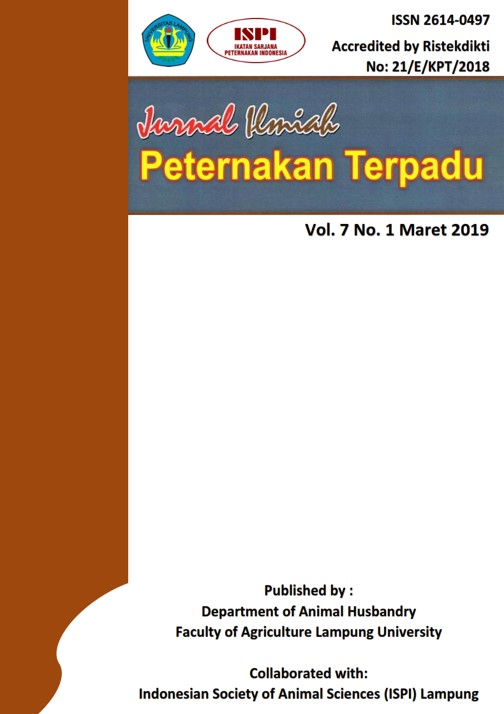PRODUKSI KARKAS DAN PERSENTASE LEMAK ABDOMINAL ITIK TEGAL JANTAN DENGAN SISTEM PEMELIHARAAN INTENSIF DAN SEMI INTENSIF DI KTT BULUSARI PEMALANG
DOI:
https://doi.org/10.23960/jipt.v7i1.p173-179 Abstract View: 1366
Abstract View: 1366
Abstract
The aims of this study was to determine the differences in intensive and semi-intensive rearing systems on body weight, carcass weight, percentage of abdominal fat, and relative income for producing carcasses of Male Tegal duck in KTT Bulusari, Pemalang. The study was conducted on April - May 2018, in Bulusari farmer group’s farm at Bulu Village, Petarukan, Pemalang District, and Central Java. The material used in this study was male Tegal ducks from 10 farmers at the Bulu Village with the object were in Petarukan Sub-district consisting of 5 semi-intensive and 5 intensive rearing systems. Tegal duck is maintained for 42 days. This research was a quantitative descriptive research that interprets a data from a research sample analyzed by the Mann-Whitney test. The results showed that male Tegal ducks that were kept intensively in Bulusari farmer group’s farm had higher body weight, carcass weight, percentage of abdominal fat and relative income than semi intensive reared duck (P < 0,05). The conclusion of this study was intensively reared ducks had higher carcass production and percentage of abdominal fat than semi intensively reared ducks.
Keywords: Tegal Duck, Rearing System, Carcass Production, Percentage of Abdominal Fat, Relative Income
Downloads
Downloads
Published
How to Cite
Issue
Section
License

Jurnal Ilmiah Peternakan Terpadu(JIPT) is licensed under a Creative Commons Attribution 4.0 International License.
Authors who publish with this journal agree to the following terms:
- Authors retain copyright and grant the journal right of first publication with the work simultaneously licensed under a Creative Commons Attribution License that allows others to share the work with an acknowledgement of the work's authorship and initial publication in this journal.
- Authors are able to enter into separate, additional contractual arrangements for the non-exclusive distribution of the journal's published version of the work (e.g., post it to an institutional repository or publish it in a book), with an acknowledgement of its initial publication in this journal.
- Authors are permitted and encouraged to post their work online (e.g., in institutional repositories or on their website) prior to and during the submission process, as it can lead to productive exchanges, as well as earlier and greater citation of published work (See The Effect of Open Access).





















